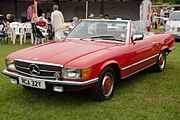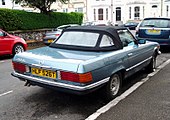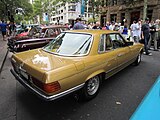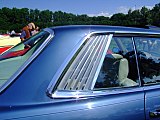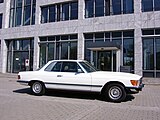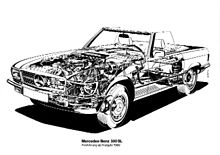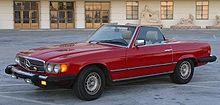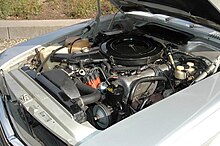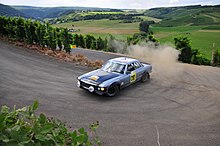Mercedes-Benz model series 107
| Mercedes Benz | |
|---|---|
| 107 series | |
| Sales designation: | SL, SLC |
| Production period: | 1971-1989 |
| Class : | Sports car |
| Body versions : | Coupé , roadster |
| Engines: |
Petrol engines : 2.8-5.6 liters (125-180 kW) |
| Length: | 4390-4750 mm |
| Width: | 1790 mm |
| Height: | 1290-1330 mm |
| Wheelbase : | 2460-2820 mm |
| Empty weight : | 1500-1720 kg |
| Previous model | Mercedes-Benz W 113 |
| successor | Mercedes-Benz R 129 |
The Mercedes-Benz R 107 is a two-seater roadster with optional rear jump seats . The sister model, the Mercedes-Benz C 107, has a longer wheelbase than the roadster and is a five-seater coupé with two full-size rear seats and a middle seat that can be used to a limited extent. The cars belong to the SL series from Mercedes-Benz .
Model history
General
The SL 107 series, which came on the market in 1971 as the successor to the so-called “Pagoda” ( Mercedes-Benz W 113 ), established a new design line at Mercedes-Benz with the broadband H4 headlights and the large, fluted rear lights . A slight wedge shape indicated improved aerodynamics . The responsible designer for this series was again Friedrich Geiger , who was already responsible for the timeless creations of the 300 SL (including the Roadster) and the Mercedes-Benz 500K . The appearance of the R107 was style-defining for Mercedes-Benz design in the 1970s. Many details can also be found in the S-Class presented in 1972, the Mercedes-Benz W 116 .
As with the previous model, the USA represented the largest sales market. The majority of the vehicles were equipped with the large-volume V8 engines. The A-pillar was specially designed for rollover, an airbag had been available since 1982.
With the 450 SLC , 450 SLC 5.0 and 500 SLC , Daimler-Benz took part in major rallies such as the 30,000 km long Vuelta à la America del Sud (1977), the Safari Rally (1979) and the Bandama Rally at the end of the 1970s (1979/1980) part.
A successor model was developed in the early 1980s, but was postponed in favor of the mid-range W124 and W201 series. As a result, the R 107 series remained on offer for a total of 18 years. The successor to the SL (R 107) was the Mercedes-Benz R 129 presented in 1989 , the official successor to the SLC (C 107) was the SEC of the 126 series presented in 1981 .
Variants SL (1972–1985)
Variants SL (1985–1989)
The 107 Roadster has been heavily redesigned over the years. Just like the drives of the S-Class at the time, the R 107 was also subject to constant change in order to adapt to changing environmental regulations. The performance and the displacement also changed several times. In 1985, the Mercedes-Benz R 107 was revised most extensively as a two-seater roadster, which could optionally be equipped with emergency seats in the rear area. From now on, if requested, the vehicles could be delivered to customers with a catalytic converter. The catalytic converter went into series production in 1986 and this component was expressly required from 1989. From 1989 onwards, the model versions without a catalytic converter could no longer be delivered. These vehicle models were known as the RÜF version from 1987, because they were so-called rearmament vehicles whose catalytic converter could be removed in an emergency.
The Mercedes-Benz R107 was produced in Sindelfingen until 1989, the successor was produced in Bremen from 1989.
Variants SLC (1971–1981)
Based on the W 111 series , the “tail fin”, Daimler-Benz presented both a coupé and a convertible in 1961, which was to be followed by a new model after a reasonable construction period. However, the next base, the slowly maturing new S-Class, was not available in time for a coupé based on it to be presented at the beginning of the 1970s. The SL base was used, especially since a well-developed design by Karl Wilfert was already waiting to be implemented in the Sindelfingen prototype building. The factory name was accordingly C 107.
The SLC, as the sports coupé was officially called, premiered at the Paris Motor Show in October 1971. Its exterior resembled that of the roadster right down to the windshield. The flat roof stretches over the five-seater passenger compartment, which ends in a huge, very sloping rear window that is curved in two directions, which in turn dictates a comparatively great length to the rear and whose trunk lid, unlike the roadster, has a slightly convex contour. In the side view, the length is documented by the larger wheelbase, 2820 compared to 2460 millimeters, and also by the line of the side windows, which, as is customary in a Mercedes-Benz coupé, can be fully retracted without an annoying B-pillar. With the SLC, however, this question posed a problem: The short distance between the door and the rear wheel arch required a complicated and therefore potentially malfunction-prone turn-tilt mechanism to allow the rear side windows to be completely lowered. Karl Wilfert's way out of this dilemma was the later stylistically controversial, but highly distinctive, double-glazed “screens” with the built-in slats that subdivide the side window and make it smaller so that the front movable part can be completely lowered.
For the first time, the standard first-aid kit was stowed in a special recess under the rear window of this car, a model for many subsequent Mercedes-Benz models up to 1995.
The SLC was offered from 1971 to 1981, first only as a 350 SLC, then from 3/1973 as a 450 SLC, from 1974 as a 280 SLC, only in the last year from 8 / 80-7 / 81 as a 380 SLC, from 8/1977 as the 450 SLC 5.0 and also only last year as the 500 SLC, with the same engines and transmission equipment as the Roadster. There was no 420 SLC, because at that time the parallel models of the W126 series of coupés were already on the market. An exception was the 450 SLC 5.0 from 1978 to 1980, in which the new light metal V8 five-liter was initially launched. In addition, this car received a front spoiler and a rubber lip as a rear spoiler for the first time in the 107 series.
The C w value of the SLC turned out to be significantly better than that of the SL, so that it achieved slightly better performance despite an additional weight of 45 to 50 kilograms. In the course of its ten-year history, the SLC has found a total of 62,888 buyers.
Security and special equipment
The new SL set new standards in the area of passive safety: Béla Barényi's safety concept with crumple zones at the front and rear and the rigid passenger cell - the “three-box principle” - was also reflected in the 1971 SL. The backbone of the R 107 was not simply a shortened and reinforced sedan floor assembly as in the predecessor, but an independent frame floor system with a closed cardan tunnel and box-shaped transverse and longitudinal members, the specialty of which was the different sheet metal thicknesses and the resulting defined crumple behavior.
Since the SL was supposed to be an open car without a targa bar, the only safety potential for the roadster in the event of a rollover was the A-pillars and windshield. They were completely redeveloped and produced 50 percent more strength than the previous version. In addition, the windshield was glued into the frame to increase strength. This resulted in considerable resistance in the roof drop test, which means that the open car was also permitted in the USA without a Targa bar. The rear window in the hardtop was also glued.
Even in the interior there were trend-setting innovations. The dashboard was flexible and foam padded in both the upper and knee areas. Another innovation was the four-spoke steering wheel, built according to the findings of the accident researchers. The already tried and tested impact pot remained; But the steering wheel rim, the four spokes, padding and hub are foamed with polyurethane . Telescopic safety steering column and the steering gear located behind the front axle complement the safety measures under the sheet metal. The vehicles have three-point seat belts as standard. The door locks were also redesigned so that they do not pop open by themselves even after an accident, but can still be opened by hand.
Easy to operate - the "fastest" of all convertibles and roadsters - was the roof of the SL, an ingeniously simple construction that dispenses with any automatism. When folded down, it disappears under a cover, as with its predecessors. The standard scope of delivery also includes the hardtop roof, which is recommended for winter use, which can be converted in a few simple steps and gives the roadster the appearance of a coupé.
The seats were available with headrests and automatic seat belts from the start. On request, instead of the standard luggage rack behind the seats, a kind of “seating option” was available at an additional cost, although it was only approved for children up to 30 kg and was very cramped.
The spontaneously reacting heating, which works independently of the dynamic pressure and is regulated by flaps, ensures well-being, supported by a new type of air conditioning of the doors. A little gag was the rechargeable flashlight built into the glove compartment. Dirt-repellent panels on the A-pillars and exterior mirrors allow a good view even in bad weather. The windshield wipers, which are arranged close to each other in the middle of the car, keep 70 percent of the window surface free, lie optimally in the airflow and do not lift off even at higher speeds.
Over the years, the range of passive and active safety equipment continued to grow. So there was ABS from 1980 and an airbag for the driver from 1982 .
As usual with Mercedes-Benz , the list of equipment extras was long and could make the car considerably more expensive. From electric windows to heated seats to air conditioning and the B-network car phone, many were offered as options.
Export models
The 560 SL (1985 to 1989) was designed as an export model for the American, Australian and Japanese markets and was never officially offered in Europe. The "bumpers" of the US models, often referred to as ugly, are rustproof.
On the 560 SL (US version), most of the body parts, such as hoods, doors, bumpers, hardtops, etc. are also marked with the original vehicle VIN (vehicle identification number / chassis number). This indicates any damage caused by an accident. Replaced parts are marked with an "R" for "replacement".
These 560 US versions were largely fully equipped from the factory. The only additional optional equipment available was seat heating.
The type 450 SLC 5.0 (from 1980 500 SLC) came up with a special feature: the large hoods were made of aluminum to save weight (due to the fact that the factory was intended to be used in rallies). It also received a small rubber rear spoiler as standard - a novelty at Daimler-Benz.
The types 450 SLC 5.0 and 500 SLC are not only different in name: While the predecessor 450 SLC 5.0 had a three-speed automatic transmission with wider gear sets corresponding to the high torque, the otherwise structurally identical 500 SLC was driven for the first time via a four-speed automatic transmission, that could only be built durable with improved materials and manufacturing processes.
Technology and innovation
Motors and drives
The engines in the R 107 were partly new designs. The V8 engines were presented in 1969 in the large sedans ( 300 SE / L ) or, like the in-line six-cylinder M 110 in the 280 SL (1974), further developments of the M 130 from the W 113 .
The in-line six-cylinder has a cylinder head with two overhead camshafts and develops 185 hp (between 2/1976 and 4/1978 177 hp). The two V8 engines were initially available (1971) with a displacement of 3.5 liters (147 kW / 200 PS, internal name M 116 ) and from 1972 also with 4.5 liters (225 PS, M 117 ).
The 3.5-liter engine is the only post-war eight-cylinder passenger car that Daimler-Benz offered with a manual transmission as standard during its entire construction period from 1969 to 1979. The manual transmission was therefore not available for the 4.5-liter M117 engine, which was only delivered to US customers until 1972. In the first year of production, the 350 SL was optionally available with the 4-speed automatic transmission with hydraulic clutch known from the 3.5 models in the W 108/109 and W 111 series.
With the US models W107 (from 1971) and W108 (from the end of 1969), the drive technology of the upcoming S-Class W116 and henceforth also for the V8 models of the 107 series was tested in advance in the USA. The automatic vehicles for the USA with the 4.5 liter eight-cylinder got a torque converter (with an additional deflection wheel) and a three-speed automatic instead of the previous Föttinger clutch (clutch only with pump wheel and turbine wheel) and four-speed automatic. Many classic-minded customers mistrusted this new technology and preferred a manual transmission. Today, eight-cylinder Mercedes with manual transmission are relatively rare and sometimes in great demand.
As a result of the first oil crisis, USA versions of the 450 SL were temporarily delivered with a low-compression engine and only around 175 hp around 1974. At that time, SLs delivered to the USA still had short bumpers like the European versions. Later, due to the changed US legislation, extended bumpers equipped with shock absorber elements were installed, which could withstand an impact at up to 8 km / h without permanent damage to the body. The exterior of this USA SL became known as the "Dallas Look" through television series. Today, some cars re-imported from the USA are converted to European headlights and bumpers, which leads to a shortage of these parts. As of the beginning of 2016, they are hardly available anymore, and if a conversion kit is offered, the price is high, usually above € 10,000. According to EU laws, the long US bumpers may remain, but the "sealed beam" headlight inserts must be exchanged for light units with EU certification.
Over the entire 18-year service life of the R 107, the engines were repeatedly adapted in parallel to the drives of the S-Class to the changed environmental regulations and changed in output or displacement. The SLC Coupé was available as the 450 SLC 5.0 from 1978 with a five-liter V8 with 240 hp and a newly designed aluminum cylinder block (Alusil). In addition to the reduction in weight, a special feature was that the friction pairing aluminum (on the piston) was reversed against iron (in the engine block) by coating the pistons with iron. In the event of a repair, drilling out an aluminum block requires special post-processing, as Alusil crystals must be exposed from the aluminum base material after mechanical processing using an etching process in order to prevent wear. This engine was then also available in the roadster as the 500 SL from 1980 - and then again in the eight-cylinder with four gears in the automatic transmission. The 450 SLC 5.0 has three gears, the 500 SLC four.
In 1985 there was the most extensive revision of the R 107: A new three-liter in-line six-cylinder ( M 103 ) with 188 hp in the 300 SL and an M 116 with 218 hp drilled from 3.8 to 4.2 liters (420 SL) . The delivery was also possible with a catalytic converter. The engine with 4.2 liters was changed in stroke and bore after a short construction period. The catalytic converter was installed as standard in 1986 and was mandatory from 1989. Versions without a catalytic converter remained available until 1989 and were called the RÜF version from 1987 onwards (back-up vehicle; a vehicle in which the catalytic converter could also be removed if necessary in countries with leaded petrol).
Contrary to many opinions, the “exotic” of the 107 series, the 560 SL, was no longer compressed in the USA from 1985 onwards due to the improved petrol quality. With a displacement of 5547 cm³ and 170 kW (231 hp) it was only marginally weaker than the European top model of the series that was not offered in America. The engine output of the 500 SL without catalytic converter was increased to 180 kW (245 hp, 165 kW or 223 hp with catalytic converter) in the same year, making it the most powerful model since production of the 107 series began in 1971. The 560 SL, however the shorter axle ratio of the 420 SL. The 560 SL was very popular in the USA, which was also proven by the sales figures. This top version of the series was the only model to have knee impact protection as an additional safety standard, as well as side impact protection with reinforcements in the doors.
Thanks to the modular system, basically every R107 can be converted with every engine available in the sedans. Even a 300 hp 560 SL with the ECE versions of the W126 sedans and coupés of the 560 SE / L or 560 SEC models offered in Europe can therefore be technically easily implemented - although then no longer original. In individual cases, conversions were made across almost the entire range of engines - from the five-cylinder diesel OM617 with 80 hp to the installation of the 6.9 liter M100 engine from the 450 SEL 6.9 , almost all contemporary Mercedes car engines can also be found in some cases in R. 107 and C 107.
| Model variants | ||||
|---|---|---|---|---|
| model | Engine type | Cubic capacity in cm³ | Power in hp | construction time |
| Roadster R 107 (SL) | ||||
| 280 SL | M 110 | 2746 | 185 , from 2/1976 177 , from 4/1978 185 | 1974-1985 |
| 350 SL | M 116 | 3499 | 200, from 2/1976 195, from 8/1977 200 | 1971-1980 |
| 450 SL | M 117 | 4520 | 225, from 2/1976 217, from 8/1977 225 | 1971-1980 |
| 380 SL | M 116 | 3818 (from year 81: 3839) | 218 , from 10/81 204, US version 155 | 1980-1985 |
| 500 SL | M 117 | 4973 | 240 , from 10/81 231 , from 9/85 245 | 1980-1989 |
| 560 SL (US version) | M 117 | 5547 | 231 | 1985-1989 |
| 300 SL | M 103 | 2963 | 188 , with cat: 180 | 1985-1989 |
| 420 SL | M 116 | 4196 | 218 , with cat: 204 | 1985-1989 |
| Coupé C 107 (SLC) | ||||
| 280 SLC | M 110 | 2746 | 185 , from 2/1976 177 , from 4/1978 185 | 1974-1981 |
| 350 SLC | M 116 | 3499 | 200, from 2/1976 195, from 8/1977 200 | 1972-1980 |
| 450 SLC | M 117 | 4520 | 225, from 2/1976 217, from 8/1977 225 | 1972-1980 |
| 450 SLC 5.0 | M 117 | 5025 | 240 | 1978-1980 |
| 380 SLC | M 116 | 3818 | 218 | 1980-1981 |
| 500 SLC | M 117 | 4973 | 240 | 1980-1981 |
The SLC in motorsport
The long-distance rally London – Sydney was for Daimler-Benz 1977 after a long break from motorsport with the first, second, sixth and eighth place a first great success in the renewed sporting engagement. Mercedes-Benz had completely stopped all motor sport activities after the catastrophic accident at the Le Mans 24 Hours in 1955. The 280 E and 450 SLC 5.0 came into question for the upcoming activities in 1978. The vehicles largely corresponded to the series and thus to the regulations. They have only been upgraded with additional high beam headlights, headlight grilles, higher body, bucket seats, roll cage, additional gasoline pumps and a trip master . The team started under the leadership of Erich Waxenberger .
The first challenge was the “Vuelta a la Americana Sud”, a mammoth rally of almost 30,000 kilometers through ten countries in South America from August 17 to September 24, 1978. The first five places went to Mercedes-Benz, including first place , two and four the 450 SLC 5.0, on three and five the 280 E.
In 1979, the Safari Rally followed from April 12 to 16, which , after a number of breakdowns and breaks, ended with a second and a sixth place for the 450 SLC 5.0 and a fourth for the 280 E.
The Bandama rally (today Ivory Coast Rally ) through the savannahs of Ivory Coast from December 9th to 14th, 1979 over 5,600 kilometers ended with a four-fold victory for the Mercedes-Benz crew. The result of 1972 showed how difficult this rally was: at that time, no car reached the finish line, so there was no winner.
In 1980, the "Dickschiff" 450 SLC 5.0 was revised again, made lighter and prepared for wider and larger tires with larger wheel openings and flared fenders. Fourth and fifth were achieved at the Rally Portugal from March 4th to 9th.
The Safari Rally in Kenya from April 3 to 7, 1980 ended with third, sixth and tenth place for Mercedes-Benz.
The Acropolis rally ran from May 24th to 30th , in which Dieter Glemser had achieved at least one place 15 years earlier. This time there was only enough space in the back. Failing brakes, stones twisting the steering, broken fuel lines and lost fuel caps had thrown back the Mercedes factory drivers.
At the Codasur Rally in Argentina from July 19th to 25th, only one team crossed the finish line and finished second.
The renewed participation in the Bandama rally in December brought a double victory this time. 50 percent of the SLC that started had reached their destination without any injuries: at this rally, which had a total length of 5,336 kilometers and only 792 kilometers of asphalt road, it was a masterpiece - and the last, because Daimler-Benz withdrew from rallying at the end of the 1980s .
literature
- Halwart Schrader: Mercedes-Benz R / C 107 1971–1989 - a documentation. 1st edition, Motorbuch-Verlag, Stuttgart 2007, (Schrader-Types-Chronik) ISBN 978-3-613-02711-4 .
Individual evidence
- ↑ Günter Engelen, Mercedes Benz 280 SL – 500 SLC , p. 13f
- ^ Oswald Werner: Foreword . In: The Anthropology of Space . University of Pennsylvania Press, Philadelphia 1983, ISBN 978-1-5128-1839-0 , doi : 10.9783 / 9781512818390-001 .
Web links
- 107SL-Club - further information on the website of the R / C107SL-Club Deutschland eV
- Sternzeit-107 - many technically oriented reports for the self-screwdriver
- Classicway R107 colors - a collection of images of the original colors of the R107 models
| Vehicle class | 1920s | 1930s | 1940s | ||||||||||||||||
| 6th | 7th | 8th | 9 | 0 | 1 | 2 | 3 | 4th | 5 | 6th | 7th | 8th | 9 | 0 | 1 | 2 | 3 | 4th | |
| Compact class | W 15 (type 170) | ||||||||||||||||||
| W 23 (type 130) | |||||||||||||||||||
| W 30 (type 150) | |||||||||||||||||||
| W 28 (type 170 H) | |||||||||||||||||||
| Middle class | W 02 (type Stuttgart 200) | W 136 / W 149 (types 170 V / 200 V) | |||||||||||||||||
| W 11 (type Stuttgart 260) | W 143 (type 230 n) | ||||||||||||||||||
| W 21 (type 200/230) | W 153 (type 230) | ||||||||||||||||||
| W 138 (type 260 D) | |||||||||||||||||||
| upper middle class | W 03 / W 04 / W 05 (types 300/320/350) | W 18 (type 290) | |||||||||||||||||
| W 10 / W 19 (types 350/370/380) | W 142 (type 320) | ||||||||||||||||||
| W 22 | |||||||||||||||||||
| Upper class | Type 400 & Type 630 | W 24 / W 29 / W 129 (types 500 K / 540 K / 580 K) | |||||||||||||||||
| W 08 (type Nürburg 460/460 K / 500 / type 500 N) | |||||||||||||||||||
| W 07 / W 150 (types 770/770 K) | |||||||||||||||||||
| Sports car | Model K | ||||||||||||||||||
| W 06 (type S / SS / SSK / SSKL) | W 24 / W 29 / W 129 | ||||||||||||||||||
| Off-road vehicle | W 103 (type G1) | W 31 (type G4) | |||||||||||||||||
| W 133 III (type 170 VG) / W 139 (type 170 VL) / W 152 (type G5) | |||||||||||||||||||
| Vans | L 3/4 | L 1000 Express | L 301 | ||||||||||||||||
| L 300 | |||||||||||||||||||


